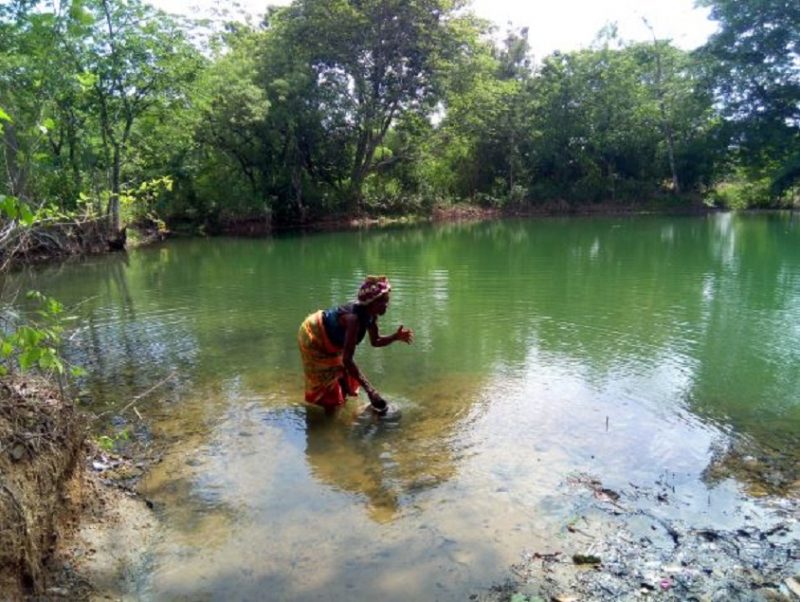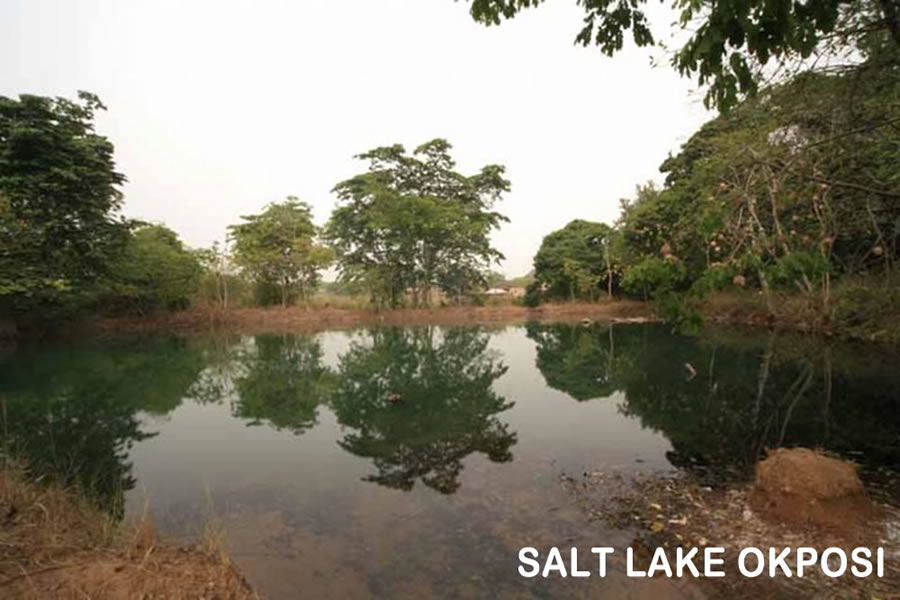
Traditional methods of salt production have continued in Okposi Okwu for about 400 years. The lake that supplies the brine was discovered almost immediately after the area now known as Okposi Okwu was inhabited. Two hunters (Ekwna Chita and Uta Anoo) discovered the lake and made their finding public when they discovered they could not quench their thirst with what they thought was ordinary water.No matter how crude the method, salt preparation is not a craft but a scientific process. No wonder the ingenuity of the women who process the salt is attributed to the mythical instruction of a god “Mmahi.” The name equally refers to the lake itself. This belief is heightened by the fact that right from the inception of this local industry, the salt producers have been making use of solar energy in an intuitive manner.
The industrial hut is known as “Ewe” and is individually owned. Once a young woman has completed her honeymoon, she is initiated into salt making practices by her fellow women. Her more elderly friends and relations decide on a day when they would fetch as many pots of the brine as they consider necessary for her. On the appointed day, the brine would be used in making puddle with which the mud part of the “Ewe” would be built. Also executed on the same day is heaping of the same puddle to form a huge mound called “Okperede” at the front of the hut. This hillock, when dry, serves as a preservative bank for salt crystals.
On her first outing, the initiate is free to fetch brine directly from “Mmahi Ezi,” the main salt lake or from “Enyanwu,” the supporting pond. Her journey would, however, terminate at a point called Oninoubam (several metres from the lake) if her first outing coincides with her menstrual period. Here, she would stop and beckon to other women who willingly supply her with as many pots of the brine as she requires. This is one of the many rules in and around the lake.Okposi salt-making hut Ewe hut (a specially constructed mud hut) used for salt-making in Okposi When she gets home, the young woman tills part of the mound that was built for her and pours more brine on it.
The new puddle is allowed to dry under the sun for several hours so that evaporation of water content takes place. The hardened puddle, now rich in salt crystals, is further broken into smaller pieces and poured into “Ofufu” (a pot perforated at the base). This pot is built into the side of the Ewe and has a fiber plug for the hole at the base. Above this hole is placed a circular piece of shard. When filled with the salty earth, the setup stimulates a simple sand filter.
At this stage, fresh brine is poured into the pot and a number of hours is allowed for the salt crystals in the earth to dissolve. Usually in the evenings, the fiber plug is removed externally. Immediately after removal, a smaller pot (ite eja) is put under the fixed pot for the purpose of overturning the shard at the base of the bigger pot so as to prevent sand from entering the filtrate. Further precaution is taken by pouring back into the filtering pot the initial drops of the percolation. The result is that the saturated filtrate “Ochichi” is not only sparkling, but yields enough pure salt crystals.

Boiling of brine to extract salt poses a big problem as Okposi is not a wooded area. In fact, even grass served as fuel in the past. Other combustible materials were sourced from surrounding villages and beyond. Many years ago, a particular type of pot “Oreohu” was used as an evaporation crucible. Later, this gave way to kerosene tins; but now, it is enamel basin that is in vogue.
Before the advent of packaging, baking of salt was the only option for the marketing of the product. As in the case of boiling, earthen wares were used for this purpose, but now metal bowls dominate because they are more durable and more convenient. The baked cones enable salt traders the opportunity of travelling far and wide to places where the commodity is in great demand.
The economic importance of the Okposi salt industry might be underestimated by outsiders, but the indigenes know that it ranks first among what made Okposi famous in the pre-colonial era. Once a highly valued merchandise, the salt attracted dealers from all parts of former Eastern and some parts of Northern Nigeria to one of the most famous markets at the time, Odenigbo Okposi. When the market lost its pride of place to the Uburu Slave Market, Okposi salt still formed the bulk of the supply in that market since Uburu salt production is seasonal owing to floods.
It would be recalled that Okposi supplied the entire Eastern Nigeria with salt during the Biafran/Nigerian Civil War. Biafran scientists, after a series of tests, declared the brine from Okposi Salt Lakes as having the highest salinity among all lakes in Eastern Nigeria. They built an industry close to the lake and taught the local women new production techniques, including the use of “alom” to effect sedimentation of dirt before decantation and ultimate filtration. The now dilapidated industry still stands as a monument of the glory that was Biafra.
Banks in Ebonyi
Brief History of Ebonyi
Business and Economy
General and Teaching Hospitals
Hotels and Guest Houses
Ebonyi State Ministries Agencies and Parastatals
Police Stations
Popular Markets
Restaurants, Bars and Night Clubs
Shopping Malls
Traditional Rulers
Golden Sand Beaches, Ndibe
Okposi Salt Lake
The Abakaliki Green Lake
FESTIVALS AND CARNIVALS
Edda New Yam Festival
Igbamgba (Wrestling Festival)
Iko Festival (Gastronomic Events)
Masquerade Festivals
New Yam Festival (Ike Ji In Unwana Dialect)
Okosa Fishing Festival
Okumkpo Masqurade Festival
Brief History of Ebonyi
Business and Economy
General and Teaching Hospitals
Hotels and Guest Houses
Ebonyi State Ministries Agencies and Parastatals
Police Stations
Popular Markets
Restaurants, Bars and Night Clubs
Shopping Malls
Traditional Rulers
TOURIST ATTRACTIONS
Abakaliki Greater Rice HusksGolden Sand Beaches, Ndibe
Okposi Salt Lake
The Abakaliki Green Lake
FESTIVALS AND CARNIVALS
Edda New Yam Festival
Igbamgba (Wrestling Festival)
Iko Festival (Gastronomic Events)
Masquerade Festivals
New Yam Festival (Ike Ji In Unwana Dialect)
Okosa Fishing Festival
Okumkpo Masqurade Festival
Connect With Us
 |
 |
 |
 |
